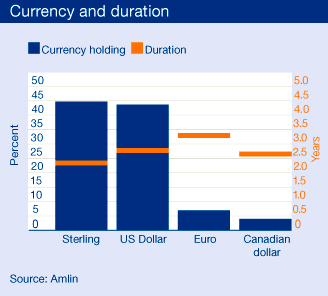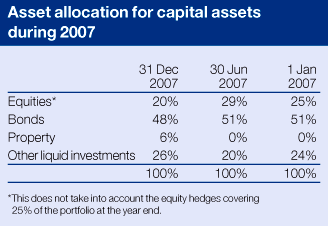Review
Financial Management – balancing financial risk and return
Investment management
Our approach to investment management is consistent with our approach to underwriting, being based on experience, diversity, risk management and management of market cycles.
We believe that investment management can provide Amlin with a competitive advantage through:
- Setting a strategic asset allocation commensurate with our risk appetite and changing it through time.
- Taking short-term tactical asset allocation positions around the strategic asset allocation and managing these positions through time.
- Identifying skilled investment managers and managing allocations to those managers.
In essence, we look to optimise returns from available asset classes for a given level of modelled investment risk. Diversification is expected to reduce risk and help to optimise returns. We also believe that the investment strategies should be transparent. This disciplined approach has been important in light of the volatile market conditions experienced during 2007.
In setting strategy we distinguish between two parts of our investments, for both London and Bermuda, because of the different levels of risk we are willing to accept for each part. Distinction is drawn between capital assets, which support the underwriting business, and policyholders’ funds, which are premium received and used to meet future claim expenses.
For policyholders’ funds, our risk appetite is relatively low. We hold assets in the major liability currencies and endeavour to make funds available to meet claims as they fall due. The short tail nature of our business means average durations of claims are also relatively short. This, together with regulatory constraints, leads us to invest in short term bonds and cash funds. The bonds are benchmarked against government bond indices with a similar duration to that of our liabilities. The investment managers, all of whom are external asset management companies, can invest away from the core government bond benchmark into securities such as corporate debt and asset/mortgaged backed securities or overseas bonds.
The currency mix and duration of assets for London policyholders’ funds at 31 December 2007 is set out below.

For Group capital, the investment horizon is longer term and this allows investment in more volatile asset classes such as equities and property although our underlying criterion of transparency remains. The strategic benchmarks for capital are set using a combination of efficient frontier1 and value at risk2 models.
The progression of the Group’s capital asset mix during the year was as follows.

Markets in 2007 were volatile as investors reacted to the slowing US housing market and sub-prime mortgage crisis. In the face of an increasingly uncertain economic outlook, particularly with liquidity issues being experienced by the banking system, the Board decided to reduce its investment risk appetite in August. Consequently the equity weighting of Group assets was reduced, and option strategies were put in place covering the remaining 25% of equity holdings. The latter provided protection for that proportion of the equity portfolio against a fall in major indices of more than 5% from 19 September to 31 December 2007, at a cost of limiting gains over the same period to approximately 4%. This option strategy was rolled over on 5 December to 31 March 2008.
On the whole, our bond portfolios were conservative in nature. The tables above show the breakdown of our portfolios by asset type, our asset/mortgage backed securities and corporate bond by credit quality, and the geographic make up of the bond portfolio.
Most sub-prime debt is included in the asset backed securities category. Amlin has limited exposure to sub-prime mortgages, with most of our mortgage bond exposure focused on the prime end of the market. Just 0.9% of the Group’s assets were in bonds backed by sub-prime mortgages and of these 92% and 8% were still rated AAA and AA respectively as at 31 December. We also have £28.2 million of assets in short duration auto loans, all AAA rated, which are designated sub-prime.
The sub-prime mortgage market remains an area of concern. However, all our bond managers are confident about the holdings in our portfolio.
